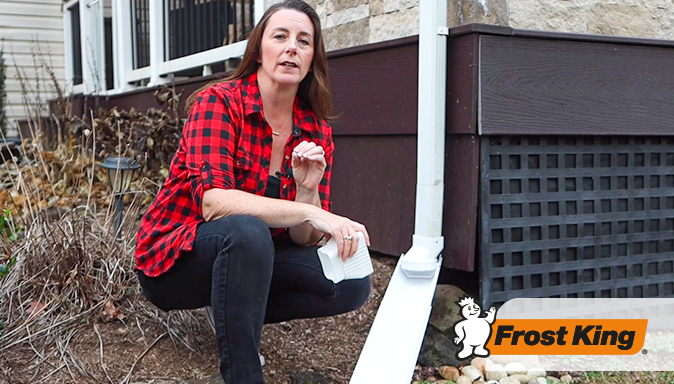Water may be an essential element of life—but when it comes to home maintenance, keeping water away from your home is essential.
If too much water is pooling around the foundation of your home, it can cause flooding in basements and crawl spaces, leading to mold, rotting wood and foundation cracks that can jeopardize the structural integrity of your home.
If you’re struggling with water management, Frost King just came out with a brand new product that makes it easier than ever to move water away from your home’s foundation. Our new Tilt and Drain Downspout extends your existing downspouts an extra 3-6 feet and swivels 180-degrees so you can easily control the direction that water flows in your yard.
But what really makes the Tilt and Drain Downspout a game changer is its innovative design that lets you easily flip it up when you want to move the extender out of the way and automatically moves back into position when it rains and water starts flowing through the downspout. Watch this video to see the Tilt and Drain Downspout in action and get easy installation tips:
4 Easy Ways to Keep Water Away from Your Foundation
If you’re struggling with drainage issues, these relatively easy fixes can keep water flowing away from your foundation:
1. Clean Gutters and Downspouts: Make sure your gutters and downspouts are functioning properly. Regularly clean gutters, removing any debris that may block the flow of water. Once the gutters are clean, install gutter screens and downspout screens to protect against future blockages and downspout extenders to keep rainwater runoff moving away from your home and towards another part of your property. Be sure to point the extensions toward an area of your yard that slopes away from the house so water doesn’t end up draining straight back towards the foundation. And be sure to avoid pointing downspouts toward your driveway, paved walkways or other concrete surfaces that don’t absorb water.
2. Add a Rain Barrel. Install an eco-friendly rain barrel to capture and store rainwater that flows off your roof and into your gutters. You can use the collected rainwater for everything from watering plants and lawns during dry spells to filling bird baths or even washing your car.
3. Check Grading: Next, make sure the soil around your home's perimeter slopes away from the foundation: this helps to prevent water from accumulating near the base of your home. If the ground around your home is completely flat or—worse—slopes towards the foundation, you’ll need to regrade the soil so there’s a drop of 6 inches in the first 10 feet from your home. To measure the slope, you’ll need two stakes, a mallet, a 12-foot long piece of string, a tape measure and a string level. Pound the first stake into the ground near the foundation and the second stake 10 feet out from your home. Wind the string around the base of the first stake and extend the string to the second stake, using the string level to make sure the string is exactly level. Measure the distance from the ground to the position of the string on the second stake to determine the slope: if it’s 6 inches or more, the slope is fine. If it’s less, you’ll need to do some re-grading of your property.
4. Maintain Landscaping: Is the ground around your plants and flowerbeds soggy or pooling with water? This is bad for your foundation and bad for your plantings, but it’s an issue that’s relatively easy to rectify over time. Work 3-4 inches of compost into bedding soil every year to improve the quality of the soil and encourage better drainage. Plant drought-resistant flowers and shrubbery that don’t need a lot of water to thrive and be strategic about how you water them by using soaker hoses to provide targeted, controlled watering.
If you’ve done all this and still have issues with water pooling around your foundation, you may need to install a foundation drainage system, such as French drains or a sump pump, to protect your foundation from water-related issues.
